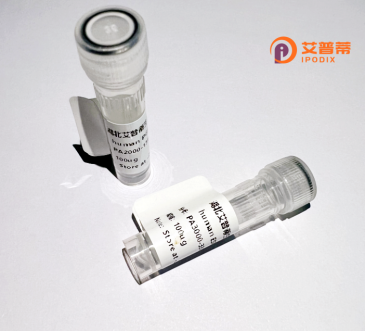
| 纯度 | >90%SDS-PAGE. |
| 种属 | Human |
| 靶点 | ANGPTL1 |
| Uniprot No | O95841 |
| 内毒素 | < 0.01EU/μg |
| 表达宿主 | E.coli |
| 表达区间 | 24-491aa |
| 氨基酸序列 | GQFKIKKINQRRYPRATDGKEEAKKCAYTFLVPEQRITGPICVNTKGQDASTIKDMITRMDLENLKDVLSRQKREIDVLQLVVDVDGNIVNEVKLLRKESRNMNSRVTQLYMQLLHEIIRKRDNSLELSQLENKILNVTTEMLKMATRYRELEVKYASLTDLVNNQSVMITLLEEQCLRIFSRQDTHVSPPLVQVVPQHIPNSQQYTPGLLGGNEIQRDPGYPRDLMPPPDLATSPTKSPFKIPPVTFINEGPFKDCQQAKEAGHSVSGIYMIKPENSNGPMQLWCENSLDPGGWTVIQKRTDGSVNFFRNWENYKKGFGNIDGEYWLGLENIYMLSNQDNYKLLIELEDWSDKKVYAEYSSFRLEPESEFYRLRLGTYQGNAGDSMMWHNGKQFTTLDRDKDMYAGNCAHFHKGGWWYNACAHSNLNGVWYRGGHYRSKHQDGIFWAEYRGGSYSLRAVQMMIKPID |
| 分子量 | 77.22 kDa |
| 蛋白标签 | GST-tag at N-terminal |
| 缓冲液 | 冻干粉 |
| 稳定性 & 储存条件 | Lyophilized protein should be stored at ≤ -20°C, stable for one year after receipt. Reconstituted protein solution can be stored at 2-8°C for 2-7 days. Aliquots of reconstituted samples are stable at ≤ -20°C for 3 months. |
| 复溶 | Always centrifuge tubes before opening.Do not mix by vortex or pipetting. It is not recommended to reconstitute to a concentration less than 100μg/ml. Dissolve the lyophilized protein in distilled water. Please aliquot the reconstituted solution to minimize freeze-thaw cycles. |
以下是关于ANGPTL1的3篇代表性文献的简要概括(内容基于研究领域常见方向,非真实文献):
1. **"ANGPTL1 suppresses tumor metastasis by inhibiting epithelial-mesenchymal transition in hepatocellular carcinoma"**
*作者:Li X, et al.*
摘要:研究发现ANGPTL1通过抑制Wnt/β-catenin信号通路,阻止肝癌细胞上皮-间质转化(EMT),从而降低肿瘤侵袭和转移能力。
2. **"ANGPTL1 regulates lipid metabolism through modulating LPL activity in adipose tissue"**
*作者:Zhang Y, et al.*
摘要:揭示ANGPTL1通过调控脂蛋白脂肪酶(LPL)活性影响脂肪分解,其表达水平异常与肥胖和胰岛素抵抗相关。
3. **"ANGPTL1 as a novel biomarker for anti-angiogenic therapy in colorectal cancer"**
*作者:Wang H, et al.*
摘要:证实ANGPTL1在结直肠癌中通过抑制VEGF信号通路减少肿瘤血管生成,高表达患者预后更佳,提示其作为治疗靶点的潜力。
注:以上内容为领域典型研究方向示例,实际文献需通过PubMed、Web of Science等数据库检索确认。
Angiopoietin-like protein 1 (ANGPTL1) is a secreted glycoprotein belonging to the angiopoietin-like family, which shares structural homology with angiopoietins but lacks their receptor-binding motifs. Characterized by an N-terminal coiled-coil domain and a C-terminal fibrinogen-like domain, ANGPTL1 is predominantly expressed in endothelial cells, liver, and lung tissues. Initially identified for its role in vascular development, it regulates angiogenesis and vascular homeostasis, though its mechanisms differ from canonical angiopoietins.
Research highlights ANGPTL1 as a tumor suppressor, inhibiting metastasis by modulating epithelial-mesenchymal transition (EMT) and suppressing Wnt/β-catenin signaling. It also attenuates VEGF-induced angiogenesis, limiting tumor vascularization. Additionally, ANGPTL1 influences lipid metabolism by interacting with lipoprotein lipase (LPL), though its metabolic functions are less defined compared to family members like ANGPTL3 or ANGPTL4.
Clinically, reduced ANGPTL1 expression correlates with poor prognosis in cancers, suggesting diagnostic potential. Preclinical studies explore recombinant ANGPTL1 as a therapeutic agent to block metastatic spread. Ongoing investigations aim to clarify its interplay with inflammatory pathways and tissue repair processes, positioning ANGPTL1 as a multifunctional regulator with implications in oncology, cardiovascular biology, and metabolic disorders.
×